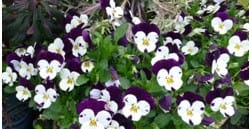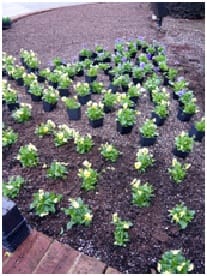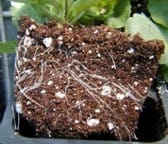Bodie Pennisi, Department of Horticulture, UGA
Cool weather is upon us and with it, pansy season! Even though pansies are the mainstay for winter color beds, there are increasingly more plant choices available, providing an exciting palette for landscapers to play with.
The following veggies are used for height, color, texture and vegetative element:
- Ornamental Cabbage
- Kale
- Swiss Chard
- Mustards
- Lettuces
- Parsley
- Cardoon (Ornamental Artichoke)
- Oregano
- Thyme
Other flowering winter annuals are:
- Alyssum
- Iberis
- Dusty Miller
- Cool season grasses
Perennial plants that serve as foliage accents are:
- Sedums
- Ivy
- Evergreens
- Acorus
- Heuchera
- Dusty Miller
- Carex
- Euphorbia – these can be year-round
Deer-resistant plants used as flowering accents are:
- Dianthus
- Snapdragons
- Poppies
- Scabiosa
The pansies and their cousins, the violas, are the bread and butter of the winter color beds, so let’s take a look at how we can keep them happy and flowering all winter long! First, a few words about each of these:

Pansies
- Larger, fewer blooms per plant
- Need minimum of 6 hours of direct sunlight
- Need dead-heading
- Slower to recover after a hard freeze
Violas
- Small, multiple blooms per plant
- Can tolerate some shade
- Self-cleaning
- Higher nutrition for better performance

Planting season starts in October, which usually gives the plants ample time to grow and develop a good root system in favorable temperatures before the winter settles in. This starts with the right foundation – the bed.
If you have existing beds, make sure you remove all plant debris from the summer planting, including any mulch. Get a soil test, which will tell you important information about the existing nutrient levels and the soil pH. Remember that pH controls nutrient availability – too high, and the plants develop deficiencies, too low, and the plants develop toxicities.
Ideal soil pH for pansies should be between 5.4 and 5.8. pH higher than 5.8 can lead to increased incidence of black root rot, a devastating disease on pansies and violas. You should test the soil later in the growing season as well, because pH does change.
Make sure you add organic matter to the bed and till well, 8-12 inches deep. Rake to create a gentle slope and trench the front edge of the bed to help with drainage. If you are making new beds, use the following soil recipe: 60% well-aged compost, 20% gravel (#89), 10% coarse sand, and less than 10% native soil.

To get a better idea of how the planting will appear – pre-set large beds. The recommended spacing for fall planting is 8” on center and 10” on center for spring planting.
Gently remove the plant from the pot by inverting the pot and squeezing the sides to release the root ball. Before you plant, examine the root system. A healthy root system has many fine white roots and is not pot-bound. Brown-colored, water-soaked roots are an indication of disease – you should not plant affected plants.
Make sure you plant at the same level the plants originally grew, not deeper, nor shallower.
Mulch is essential for many reasons – weed control, keeping soil temperatures higher, and preventing soil desiccation. Small-size pine nuggets work very well.
After a thorough watering you should liquid-feed the plants for faster establishment. In addition, top-dress the beds with a slow-release fertilizer to ensure an adequate level of fertility.
Low temperatures will become an issue as winter settles in. Even though the soil in Georgia very rarely freezes (exception in the Mountains), soil temperatures below 45oF causes slow growth due to low uptake of nutrients. Plants stop flowering and appear starving even if high fertility is present in the soil!
When soil temperatures drop below 60 oF, begin a liquid feed program with a formula having at least 50% nitrate nitrogen, such as calcium nitrate, potassium nitrate, or magnesium nitrate. The reason being is that ammonia-based fertilizers are not utilized because the bacteria responsible for converting them to a form that the plant roots can absorb are not as active in temperatures below 60 oF. Applying ammonia fertilizer is not only a waste of money but it can also compromise the health of your pansies and violas.
For best results, apply a standard 15-2-20 formula, high-nitrate pansy formula fertilizer at 4-day intervals through March 15. These formulations also have little effect on soil pH, so nutrient deficiencies are less likely to occur. Fertilization frequency depends on the vigor and performance of the planting – more frequent feeding may be needed when the growth is good. If a period of warm weather occurs, cut back on the liquid feed to avoid foliar stretching during the midwinter, which may result in weak, floppy stems. When fertilizing with liquids, apply enough liquid to saturate soil to a depth of 4- to 6-inches.
Removing frost-damaged flowers and old, faded flowers should be a top priority with pansies; not only for aesthetics but to prevent the onset of seed pods that consume the plant’s energy. This also reduces the changes of fungal blight diseases that feed on old blossoms. Trim lanky shoots periodically to encourage branching, compact growth and improved flowering.

Emphasizing again the soil pH, make sure you test during the season. If the soil pH rises above 5.8, drench at 10-day intervals with either iron sulfate or aluminum sulfate (1 to 3 lbs/ 100 gal) to lower the pH. Lightly rinse plants after application to prevent foliage injury. Continue these corrective treatments until the soil pH drops and stays in the 5.4 to 5.8 range.
Soil temperatures usually are on the rise by March 15, so you can start using fertilizers containing ammonia nitrogen. Use the standard fertility program for summer annuals – 200 ppm 20-20-20 (N-P-K) or a slow release/granular fertilizer during the remainder of the growing season.